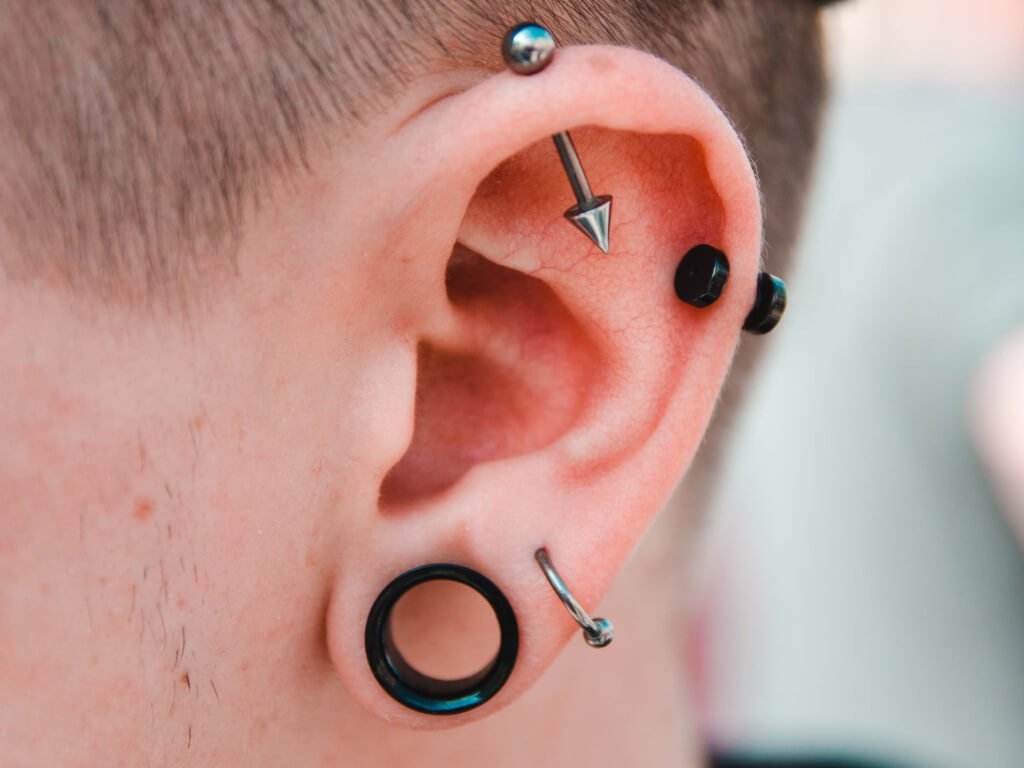Piercing Care: Do you know how to care for it properly?

Introduction
When it comes to getting a new piercing, we look forward to that moment but then do we know how to take care of it? Getting a new piercing is certainly an exciting and significant moment in our lives, but it must be remembered that having the right piercing care information is essential to ensure smooth healing and to keep the piercing beautiful to look at and above all healthy over time. Each type of piercing requires specific care to preserve the area and prevent possible complications; in this article we will explore the essential steps for post-piercing care, along with practical tips to ensure fast and effective healing.
Index
- What to do after piercing
- What not to do after piercing
- Specific care for different parts of the body
- Healing time and normal symptoms
- When to consult a professional
- Conclusions
What to do after piercing
1. Regular and gentle cleaning
The first fundamental step to learn in your post-piercing routine is to devote the necessary time to the regular and gentle cleaning of the hole; it may seem obvious but getting into this good habit right from the start will allow you to enjoy optimal healing of the piercing. In fact, for this type of wound that the piercing creates, the body will not be able on its own to form a crust that will be able to protect the hole from external pathogens, but you will have to do this on a daily basis by keeping the hole as clean as possible.
If you devote the right amount of care and attention at this stage, the skin that will later re-form around the jewel will find a healthy and clean environment, and the appearance of your piercing will be almost perfect.
“But how many times a day should the new piercing be cleaned?”
You only need to gently wash the area twice a day using mild detergent and lukewarm water. After washing the area it is essential to dry the piercing thoroughly with a clean cloth to avoid a build-up of moisture (a favourable environment for germs and bacteria).
2. Use of physiological solutions
Phygiological solutions are valuable allies for healing piercings; apply these solutions to the piercing area at least two to three times a day.
Physiological solutions help to keep the area clean, reducing the risk of infection and promoting faster healing.
To disinfect the area we recommend the exclusive use of these solutions, so do not use alcohol, hydrogen peroxide or aggressive products, as they can irritate the skin and delay healing.
3. Changing jewellery only after healing
This is one of the most eagerly awaited moments for people: the jewellery exchange!
Beautiful things are always the most eagerly awaited, but never more so than in this case you must wait and be patient, because you risk negatively altering the piercing area and creating complications for the piercing.
In fact, a common mistake is to remove the initial piercing too early; the initial piercing, in its basicness, is specifically chosen to facilitate healing and should remain in place until the hole is completely healed.
“But how long does a piercing take to heal?”
Most piercings take from 6 to 12 weeks to completely heal, but the time can vary depending on the body part and type of piercing.
Arte Viva recommends that you always consult the piercer who performed the piercing for a jewel change.

4. Keeping hands clean
During the healing period of a piercing the hands, which must always be clean, are a fundamental aspect.
A good rule, which benefits the health of our skin first and foremost, would be never to touch the face with dirty hands; with this in mind, we must remember that having a new piercing is equivalent to having a small wound that must be cared for over time, so we must take the right care, especially at the level of hygiene.

In fact, during the day we touch objects and surfaces that can be soaked in bacteria or germs, a prime example being our beloved smartphone: various studies have ascertained that the screen of a smartphone harbours 80% of human bacteria, microorganisms and bacteria of all kinds.
Therefore, if hands are not washed they can negatively affect the piercing, as germs and bacteria coming into contact with the hole can be a source of infections. Always remember: before touching your piercing, if you absolutely must do so, always wash your hands thoroughly with antibacterial soap.
What NOT to do after piercing
- Avoid touching the piercing with dirty hands:
Touching the piercing with dirty hands is a major risk factor for infection. Although it may be tempting, avoid touching the piercing without first washing your hands thoroughly with antibacterial soap. - Do not remove the jewellery before it has healed completely:
The temptation to change the jewellery as soon as the piercing is done can be strong but resist the temptation. The initial jewel was chosen specifically for healing and its early removal can cause irritation and complications: do not remove the jewel before the piercing is completely healed, unless strictly necessary for medical reasons. Arte Viva recommends a visit to the studio for a possible jewel change. - Avoid baths:
During the healing period, it is advisable to avoid contact with water from the sea, swimming pools, saunas, or hot baths, as they may contain harmful bacteria. - Do not touch continuously the jewel:
Do not rotate or move the jewel during the healing phase. This could irritate the tissue. - Do not wear tight or rough clothing:
Choose comfortable, breathable clothes that do not rub or irritate the piercing. - Do not use makeup or creams on the piercing area:
Avoid applying make-up, lotions or creams on the piercing area, as they can clog pores and delay healing.
Specific care for different parts of the body
Each body part has its own characteristics and requires specific post-hole care. Here are some tips for the care of some common types of piercings:

Nose piercing
Gently clean both the inside and the outside of the nose with a saline solution. To ensure optimal cleansing also on the inside, we recommend the use of the thermal nasal spray, a method to keep the inside walls of the nose clean at all times.
Avoid blowing your nose aggressively so as not to irritate the piercing.
Ear piercing
Avoid sleeping on the side of the piercing in the first few days, to avoid pressure and rubbing.
Lip or tongue piercing
Rinse your mouth with a non-alcoholic mouthwash after every meal and before going to bed. In the first few days, avoid use of alcohol and don’t smoke, they would lead to major complications in healing.
Belly piercing
Choose clothes that are comfortable and not too tight to avoid irritation in the piercing area.
Healing time and normal symptoms
The healing time varies depending on the body part and the type of piercing, but usually ranges from 6 to 12 weeks. During the healing period you may experience some normal symptoms such as redness, swelling and clear discharge. You should not have any worries should this happen to you, because these symptoms are part of the healing process.
You have to think that our body has to heal a wound in which there is an element unknown to it, so it is quite normal for the body to respond in this way.

When to consult a professional
If you notice signs of infection such as intense redness, abnormal swelling and yellowish or green discharge, it is essential to consult a professional immediately. Other warning signs include:
- persistent bleeding and pain
- the piercing seems not to heal or worsen despite correct treatment
We at Arte Viva Tattoo advise you, if you recognise any of these signs, to go to your piercer’s studio as soon as possible to resolve the situation as best you can.
Do not improvise in do-it-yourself methods, it is a matter of the health of your body, so always and only go to professionals.
Conclusions
Carefully following the advice given and taking the right precautions is essential for a perfect healing of your new piercing. As we have seen together each body part has its own specific requirements, so make sure you follow the instructions carefully.
If you have any doubts or would like advice contact us.

